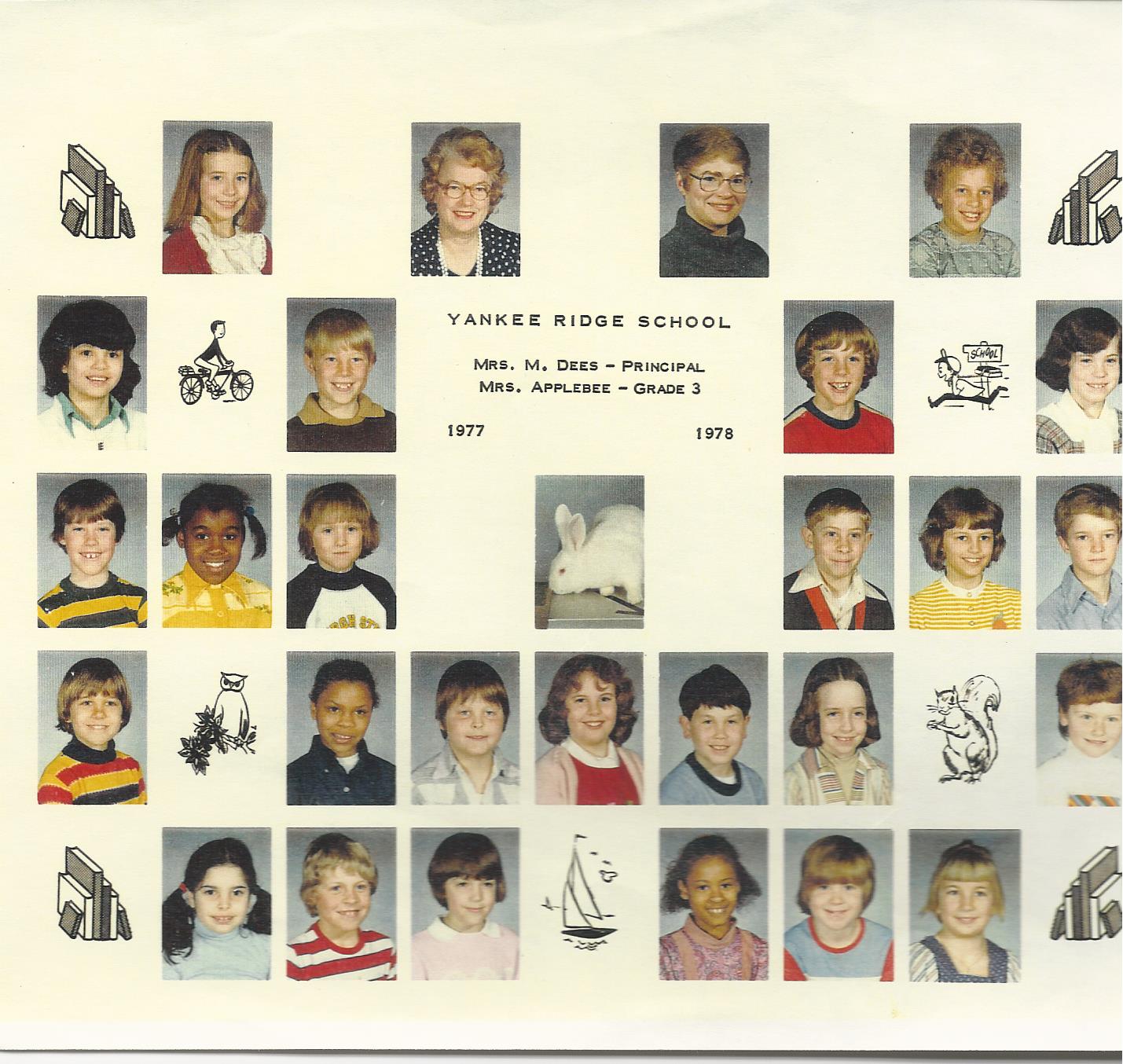Preface
November 1977
 “Meggie! What do you want to wear today?” It was my Mom, and it was Picture Day at school. I was excited. Not only was my class having our photo taken, but our class bunny, Snowball, was also going to be included in the photo. I absolutely adored this white bunny, and as far as I was concerned, he was the star of our class. To make it even better, every weekend, our teacher Mrs. Applebee allowed a different student to have Snowball sleep over at his or her home. I had just had my turn.
“Meggie! What do you want to wear today?” It was my Mom, and it was Picture Day at school. I was excited. Not only was my class having our photo taken, but our class bunny, Snowball, was also going to be included in the photo. I absolutely adored this white bunny, and as far as I was concerned, he was the star of our class. To make it even better, every weekend, our teacher Mrs. Applebee allowed a different student to have Snowball sleep over at his or her home. I had just had my turn.
“Mommy, will you put my hair in pigtails?” I planned to wear my favorite light blue turtleneck that day. Other than worrying about my hairstyle and whether Snowball would remember to smile for the camera, I actually hadn’t given the class photo a thought. Although by this age I had started to hide my hands in pictures, at least sometimes, for this class photo there was no risk. Unlike most school photos, where kids are assembled together along with their teacher, my elementary school chose to simply have the “floating head” style. It would show a collage of our faces only, with no hint as to whether a kid was small, tall or perhaps even in a wheelchair or missing fingers.
Floating heads or not, I felt really close to my teacher and the kids in my class. As far as I was concerned we were all simply a bunch of third graders and a bunny, in the same class, smiling.
January 2013
It was late and I had to get up early the next morning for work, but I couldn’t put Ethan’s book, “Wonder” down. The prior week, our ten -year-old, born with my disfiguring condition, had pleaded that I read it. In it, Auggie, a boy in middle school, was born with a severe facial deformity. Within the first couple of paragraphs, I was hooked. The book was incredibly insightful, helping readers appreciate what it’s like living life looking so blatantly different than the majority. Of course we could relate. As I sat up engrossed reading the final chapter in my bed at 1:00am, a tear slid down my cheek. Auggie had just said something significant that penetrated:
-year-old, born with my disfiguring condition, had pleaded that I read it. In it, Auggie, a boy in middle school, was born with a severe facial deformity. Within the first couple of paragraphs, I was hooked. The book was incredibly insightful, helping readers appreciate what it’s like living life looking so blatantly different than the majority. Of course we could relate. As I sat up engrossed reading the final chapter in my bed at 1:00am, a tear slid down my cheek. Auggie had just said something significant that penetrated:
“The only reason I’m not ordinary, is that no one else sees me that way. To me, though, I’m just me. An ordinary kid.”
 Recently, my Today Show segment buddy and friend, who I greatly admire and respect, Dr. Jennifer Hartstein, passed me an article about Miles Ambridge. Miles is an eight-year-old who was born with Spinal Muscular Atrophy and has spent his life in a wheelchair. The piece was titled, “The Class Photo that Broke a Mother’s Heart.” In it, Miles’ is sitting in his wheelchair, smiling for his class photo. However, Miles and his chair were positioned about three feet away from his second grade class and teacher, while he cranes his neck so he can be a part of the picture. The photo is really problematic. Despite Miles’ smile he appears in the photo as if he’s an after-thought, separate and removed from his classmates. I decided to post the class photo on my DHIFI Facebook page, to invite reaction. I was not surprised at the outpouring of disapproval of how the photographer, or possibly the school itself, made such a blatant error. One person summed it up rather aptly. “Shame on them.”
Recently, my Today Show segment buddy and friend, who I greatly admire and respect, Dr. Jennifer Hartstein, passed me an article about Miles Ambridge. Miles is an eight-year-old who was born with Spinal Muscular Atrophy and has spent his life in a wheelchair. The piece was titled, “The Class Photo that Broke a Mother’s Heart.” In it, Miles’ is sitting in his wheelchair, smiling for his class photo. However, Miles and his chair were positioned about three feet away from his second grade class and teacher, while he cranes his neck so he can be a part of the picture. The photo is really problematic. Despite Miles’ smile he appears in the photo as if he’s an after-thought, separate and removed from his classmates. I decided to post the class photo on my DHIFI Facebook page, to invite reaction. I was not surprised at the outpouring of disapproval of how the photographer, or possibly the school itself, made such a blatant error. One person summed it up rather aptly. “Shame on them.”
But I was particularly focused on one of the author’s lines in the article: “Miles knows he’s different than the rest of the kids, but he still tries to fit in. The photo was a clear example of how set apart her son is from society.”
Although I similarly took issue with how Miles was placed so blatantly separate from his class and teacher, I admittedly wasn’t sure whether the photo should be interpreted as Miles trying to fit in. That felt like an assumption, so I again reached back out to Dr. Hartstein. Her response resonated: “Meg, I too couldn’t help but wonder what “fitting in” meant…does he already have friends and feels as though he is part of the crowd, but that was ignored by the photographer and others when setting the photo? Maybe he doesn’t feel excluded, and didn’t know what to say to be more included in the picture, so he leaned in as it was all he knew how to do?”
I couldn’t help but think about parenting my own kids who have a visible difference. When I showed the photo of Miles and his class to Ethan, his reaction was, “Mom, that was ridiculous to have Miles sit so far away from his class. That photographer was dumb to do that. But I wonder, photos like these happen during one class period, once per year. I wonder how Miles is treated during school for the rest of the year? Most importantly, I wonder how he feels about himself? If it were me, I would smile and be happy because I already know where I stand with my friends, no matter where they placed me in a class photo. Just because I look different, doesn’t mean I feel any less equal to them.”
 The following day, I noted that the media circulated a corrected photo, with Miles now sitting alongside his classmates, wheelchair nowhere in sight. Admittedly, when I saw the new class photo, although I probably am in the minority, my heart sank a bit at the sight of the revised picture. While I was happy to see that Miles was no longer so blatantly separated from the others, the new image didn’t sit well with me either. With his wheelchair now missing, I couldn’t help but wonder why they had to make that particular correction. Why couldn’t the best picture be of his class surrounding Miles, wheelchair and all?
The following day, I noted that the media circulated a corrected photo, with Miles now sitting alongside his classmates, wheelchair nowhere in sight. Admittedly, when I saw the new class photo, although I probably am in the minority, my heart sank a bit at the sight of the revised picture. While I was happy to see that Miles was no longer so blatantly separated from the others, the new image didn’t sit well with me either. With his wheelchair now missing, I couldn’t help but wonder why they had to make that particular correction. Why couldn’t the best picture be of his class surrounding Miles, wheelchair and all?
It is my hope that Miles’ is embraced by his classmates on or off camera, but to me, removing Miles’ wheelchair for the updated photo felt like the equivalent of someone asking me (or my boys) to shove our hands in our pockets before we, “smile for the camera.” Miles cannot walk on his own. He simply wants everyone else to see him as “ordinary,” as he views himself. But for Miles, the wheelchair is his norm, and it is what makes him, him. If having him “fit in” means hiding or temporarily removing something that is essential to his daily life function and capabilities, then I don’t think anything was gained by the re-take. Rather, it reminds him that others cannot view him as one of them, unless he removes his chair.
And so, I can’t help but to wonder if instead, by taking the second photo, Miles is left to believe that the only way a class photo can look right with him in it, is to remove what makes him different.
I wonder.





